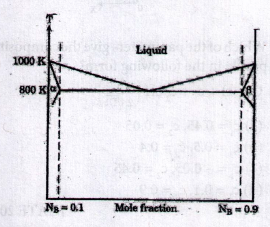61. Dislocation cross-slip is difficult in those materials which have
62. The number of components is 2, the number of phases are 3 and degrees of freedom are 0. Then which of the following equilibrium is it?
63. In the hypothetical phase diagram, the melting point of each pure component is. 1000 K and the eutectic temperature is 800 K. The eutectic is located at the equi-atomic composition. The maximum solid solubility in α-phase is given by the mole fraction, Ne = 0.1.
The freezing range (in K) of the alloy with composition, Ne = 0.1 is

The freezing range (in K) of the alloy with composition, Ne = 0.1 is

64. With the increase in the degree of supercooling, the growth rate of a nucleus follows which one of the following trends?
65. Match the heat treatment process in Group I
with resultant microstructure Group II.
Group I
Group II
P. Martempering
1. Coarse pearlite
Q. Normalising
2. Fine pearlite
R. Sub-critical annealing for long time
3. Tempered martensite
S. Full annealing
4. Spheroidised cementite in the matrix of ferrite
| Group I | Group II |
| P. Martempering | 1. Coarse pearlite |
| Q. Normalising | 2. Fine pearlite |
| R. Sub-critical annealing for long time | 3. Tempered martensite |
| S. Full annealing | 4. Spheroidised cementite in the matrix of ferrite |
66. Match the items in Group1 with those in Group2.
Group 1
Group 2
P. Fatigue
1. Cracking at extrusions and intrusions
Q. Hall-petch equation
2. Dislocation pile up
R. Creep
3. Slip and twinning
S. Plastic deformation
4. Grain boundary sliding
5. Angle of grain boundary
6. Young's modulus
| Group 1 | Group 2 |
| P. Fatigue | 1. Cracking at extrusions and intrusions |
| Q. Hall-petch equation | 2. Dislocation pile up |
| R. Creep | 3. Slip and twinning |
| S. Plastic deformation | 4. Grain boundary sliding |
| 5. Angle of grain boundary | |
| 6. Young's modulus |
67. Determine the correctness or otherwise of the following Assertion (a) and Reason (r).
Assertion (a): Peak aging time for an Al-4 wt.% Cu alloy is indicated by a maximum in the hardness.
Reason (r): The maximum volume fraction of the θ precipitates is formed at the peak aging time.
Assertion (a): Peak aging time for an Al-4 wt.% Cu alloy is indicated by a maximum in the hardness.
Reason (r): The maximum volume fraction of the θ precipitates is formed at the peak aging time.
68. The stress required for Orowon dislocation bypass is 200 MPa in an alloy when the interprecipitate spacing is 500 nm. In the same alloy, if the inter-precipitate spacing is reduced to 200 nm, the stress required (in MPa) is
69. The self diffusion in FCC metals occurs by one of the following mechanisms.
70. A binary alloy system A-B shows the peritectic reaction, L + α (⟶β). An alloy of the peritectic composition when cooled under natural cooling conditions will show coring in
Read More Section(Physical Metallurgy)
Each Section contains maximum 100 MCQs question on Physical Metallurgy. To get more questions visit other sections.
